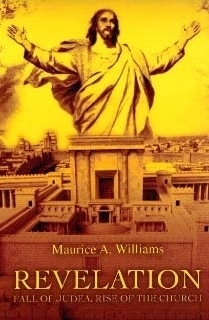
REVELATION: FALL OF JUDEA, RISE OF THE CHURCH
Maurice Williams
iUniverse (2008)
ISBN 9780595484294
Reviewed by Dr. Michael Philliber for www.RebeccasReads.com
What does the Revelation mean? Was it written to tell how the 21st Century is to unfold? Can we really expect world-dominating beastly characters to arise and force computer chip implants on people? Is there any real sense to this apocalyptic volume in the Bible? To answer these questions and many others, Maurice Williams bravely takes a swing at interpreting this rather picturesque and alarming final book of the New Testament, in his “Revelation: Fall of Judea, Rise of the Church”. This fairly readable, 223-page paperback was written by a Roman Catholic layman, for laypeople.
One of the immediate and obvious ideas that will strike the reader is that in “Revelation: Fall of Judea, Rise of the Church” the author makes clear he does not feel that much of the book of the Revelation is foretelling the far distant future of the 21st Century. In a day when end-times prognosticators are drawing charts and writing popular fictional stories about Christ’s return and claiming to get all their source material from the Revelation, Williams brings some fresh air. As the title mentions, the writer perceives that much of the 1st Century New Testament book known as the Revelation was about the fall of Jerusalem and the end of the Temple. Williams does a delightful job turning the historical substance of the ancient writers Josephus, Suetonius, and Tacitus into easy-to-understand resources to make his case for seeing much of Revelation as rehearsing the downfall of 1st and 2nd Century Judaism.
There are two weaknesses I see to “Revelation: Fall of Judea, Rise of the Church,” one that is exegetical, and the other which will limit its readership. The exegetical weakness is that Williams regularly interprets passages in ways that seem to have nothing to do with either the text, or with the Bible as a whole. For example, when dealing with chapter 4 and 5 of the Revelation, he sees the Trinity in things that seem to have nothing to do with the Trinity, and he doesn’t make his case Biblically. The other weakness is that in the last 19 pages of the book he recounts the numerous stories of the appearing of the Blessed Virgin in an attempt to make a concluding point. Williams also attributes the Protestant Reformation to the loosing of Satan from his 1,000-year bondage. This will unnecessarily narrow his readership to a limited group of Catholic readers, and keep his book from reaching a larger audience.
At the end of the day, “Revelation: Fall of Judea, Rise of the Church” is a historical approach to understanding the meaning of the Revelation written by a Roman Catholic layman for predominantly Roman Catholic laypeople. Though it may be a bit off-putting to Protestants, I would recommend it as a resource for broadening a person’s understanding of what the Revelation was about and its purpose.
Back to Previous Page